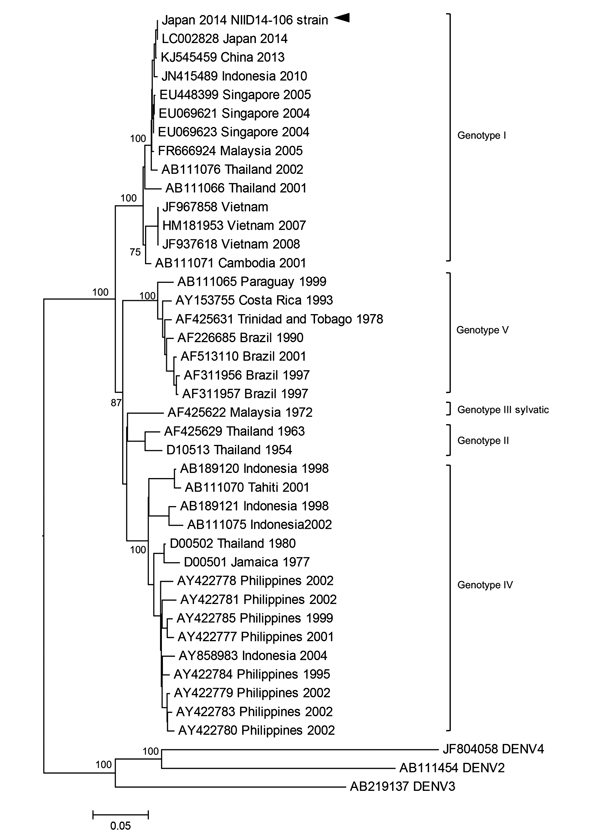Autochthonous Dengue Fever, Tokyo, Japan, 2014
Satoshi Kutsuna

, Yasuyuki Kato, Meng Ling Moi, Akira Kotaki, Masayuki Ota, Koh Shinohara, Tetsuro Kobayashi, Kei Yamamoto, Yoshihiro Fujiya, Momoko Mawatari, Tastuya Sato, Junwa Kunimatsu, Nozomi Takeshita, Kayoko Hayakawa, Shuzo Kanagawa, Tomohiko Takasaki, and Norio Ohmagari
Author affiliations: National Center for Global Health and Medicine, Tokyo, Japan (S. Kutsuna, Y. Kato, M. Ota, K. Shinohara, T. Kobayashi, K. Yamamoto, Y. Fujiya, M. Mawatari, T. Sato, J. Kunimatsu, N. Takeshita, K. Hayakawa, S. Kanagawa, N. Ohmagari); National Institute of Infectious Diseases, Tokyo (M.L. Moi, A. Kotaki, T. Takasaki)
Main Article
Figure 2

Figure 2. Phylogenetic analysis of a dengue virus (DENV) sequence derived from a patient with confirmed autochthonous dengue fever (patient 2), Tokyo, Japan, contracted during August 26–September 22, 2014. Phylogenetic tree is based on the envelope protein genome sequence of selected dengue virus type-1 (DENV-1) strains. DENV-2, DENV-3, and DENV-4 serotypes were used as outgroups. Percentages of successful bootstrap replication are indicated at the nodes. DENV-1 genotypes are indicated on the right. The DENV-1 National Institute of Infectious Diseases (NIID) strain 14-106 (GenBank accession no. LC006123) is indicated with an arrowhead. Virus strains are indicated by GenBank accession number, place, and date of isolation. Scale bar indicates number of nucleotide substitutions per site.
Main Article
Page created: November 02, 2017
Page updated: November 02, 2017
Page reviewed: November 02, 2017
The conclusions, findings, and opinions expressed by authors contributing to this journal do not necessarily reflect the official position of the U.S. Department of Health and Human Services, the Public Health Service, the Centers for Disease Control and Prevention, or the authors' affiliated institutions. Use of trade names is for identification only and does not imply endorsement by any of the groups named above.
